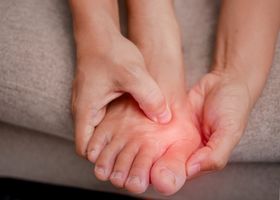Different Types of Flat Feet and Their Symptoms
Learn about the different types of flat feet, their common and uncommon symptoms, and what you can do to manage and treat the condition.
Updated February 16, 2023.
Flatfoot, also known as pes planus, is a medical disorder where the entire sole rests on the ground when standing. Flatfoot occurs when there is total or partial depression of the foot arch. If you suspect you have flat feet, you can confirm by wetting your feet and then standing on a sheet of paper. Observe the imprint of the foot. In a healthy foot arch, the portion of the imprint that connects the heel to the ball should be about one-third to one-half of the diameter of your whole foot. You have flat feet if the entire outline of the foot is visible on the surface.
Managing Flat Feet
Management of flat feet depends on the type, stage, and symptoms. Whether flexible, rigid, or adult-acquired, early treatment with anti-inflammatories or certain exercises can help reduce inflammation and relieve pain. Pain can also be alleviated using a multitude of natural treatments. However, specific shoes and custom insoles for flat feet orthotics present a better option for managing flat feet. Upstep orthotics provide adequate support for the foot and thus restore the alignment of the leg, relieve undue stress, and reduce pain.
Common Types of Flat Feet
Flexible Flat Feet (FFF)
Flexible flat feet are the most common. In this type, arches are present when sitting but disappear upon standing. It is common during childhood and teenage years and usually doesn't cause pain or other symptoms. However, some cases of FFF can be symptomatic and require medical intervention before the condition worsens or leads to further complications.
Rigid Flat Feet (RFF)
Whether standing or sitting, a person with rigid flat feet has no visible arches. Often, this develops during the teen years and gets worse as age progresses, usually causing pain and discomfort around the heel or arch area, difficulty standing on your tiptoes, and even swelling and tenderness around the ankle.
This type of flatfoot is also a risk factor for other problems, such as knee, hip, and back pain.
Uncommon Types of Flat Feet
Adult-Acquired Flat Feet
With adult-acquired pes planus, the arch collapses unexpectedly due to trauma or injury to the posterior tibial tendon, and symptoms can be the same or worse than RFF.
Vertical Talus
A birth defect (congenital disability) called vertical talus leaves the talus (the bone that makes up the lower part of the ankle joint) malaligned and can prevent arches from forming at all.
Related Articles

Super Shoes: What Are They and How Do They Work?
Upstep Staff
September 19, 2024

Tailor’s Bunion: Causes, Symptoms, and Treatment
Dr. Pooja Gajare
February 10, 2023

Do Epsom Salt Foot Soaks Help Plantar Fasciitis?
Janik Sundstrom
December 9, 2024

3 Best Insoles for Standing on Concrete All Day—Podiatrists’ Choice for 2025
Babafemi Adebajo
December 6, 2024

Best Insoles for Snowboard Boots for Navigating Snowy Trails
Janik Sundstrom
December 5, 2024
Related Posts
Babafemi Adebajo
How to Relieve Flat Feet and Fallen Arches Pain
Babafemi Adebajo
Upstep Custom Orthotics for Flat Feet—2025 Review
Janik Sundstrom
Conservative and Invasive Treatments for Flat Feet
Janik Sundstrom
Best Orthotics for Flat Feet and Plantar Fasciitis
Janik Sundstrom



